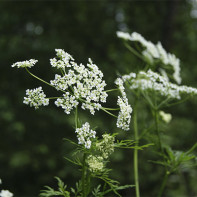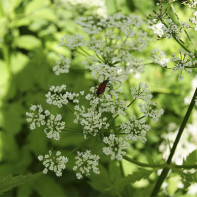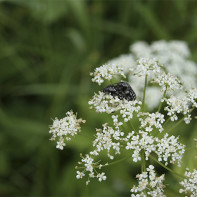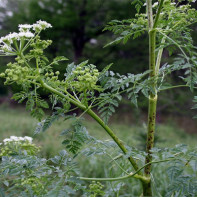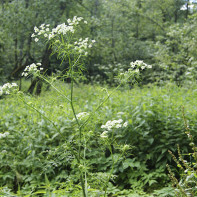Hemlock: therapeutic properties and contraindications
Many centuries ago, Paracelsus said that "everything is a poison, everything is a cure", adding that the effect depends on the dose. This is fully applicable to hemlock. It is also called angelica dogwood, holodendron, omega, trunk poisonous, or wild parsley. It exudes an almost imperceptible odor that gives you a headache. A person becomes uncomfortable around the plant. Knowing about this feature, people try to quickly get away from the glade with the plant in the woods, and on the dacha plot decisively get rid of it. It also has valuable medicinal properties, which are well known and used in folk recipes, but you need to be very strict about the dosage and method of preparation.
- How it looks and where it grows
- Collection and storage
- Chemical composition
- Therapeutic properties of hemlock herb
- Types of medicinal compositions
- Infusion
- Tincture
- Powder
- Tampons
- Oil
- Oil based ointment
- Hemlock enzyme
- The use of hemlock in folk medicine
- Tischenko Method
- Hemlock in gynecology
- Side effects
- Contraindications
- Interesting Facts
How it looks and where it grows
Hemlock is so undemanding that it grows in almost any soil, without fear of the eternal penumbra of the forest and open to the hot sun glades. By its appearance it is easy to determine how rich in beneficial substances the soil is. On a well fertilized with humus the plant looks like a luxurious bush with spectacular pinnate leaves, on depleted sites its size is much more modest.
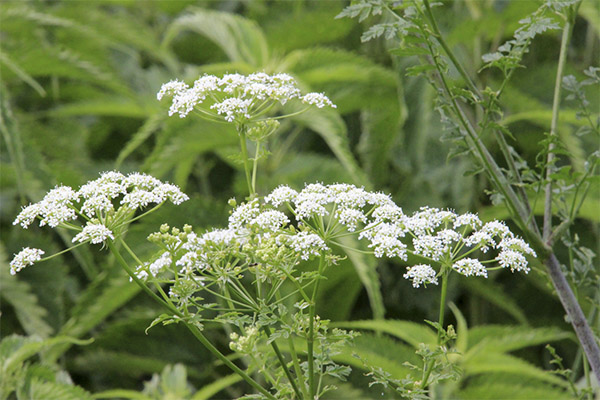
The plant is two-year old, in the first year it develops a spindle-shaped root and a root rosette with lush sprouts of leaves. At this stage it looks like parsley. It is dangerous just by its outward resemblance, it has no smell or bitterness in taste, so it is possible to poison people and livestock. The only difference is a very slight tinge of odor, similar to that of a mouse, if you rub the leaves in your fingers.
In the second year, the stem begins to grow. In a favorable environment its height reaches 180-200 cm, inside it is hollow, with longitudinal grooves. The leaves are sparsely arranged along it, in pairs, decreasing in size from the root to the crown. Inflorescences are formed in the form of multi-compound umbrellas, the flowers are small, white, blooming from June to early August. Seeds are formed in September. They are very small, similar to dill, weighing about 1 thousand pieces is 1.4 g.
Hemlock is found in Europe, Turkey, China, Morocco, Ethiopia, North Africa. In Russia it is widespread everywhere, up to the regions of the Far North. It does not fear frosts, drought, grows along the banks of rivers, lakes, along roads, in landfills and near human habitation.
Gathering and storage
The plant gains strength during flowering. Harvesting begins in June. It is not difficult to find hemlock, but it is necessary to take into account certain rules when harvesting it.
- The ground part should not be touched with bare hands, it is necessary to be equipped with rubber gloves. If you plan to collect a large batch, it is better to take with you a gauze bandage to protect the respiratory organs.
- Put the cut parts together with other plants is not allowed. A separate bag or container is allocated for wild parsley. Keep in mind that the sap of an already cut herb continues to retain a fraction of its toxicity.
- Tasting the raw material is strictly prohibited, you can get severe food poisoning.
- Grass is not collected near roads, industrial plants, landfills.
Medicinal properties are concentrated in the stem, leaves and flowers, the root in folk medicine is practically not used. Cut the top of the plant, about 2/3 of its height. Separately collected juicy leaves from the root rosette.
Remember: plants infested by pests with signs of disease are not suitable for the preparation of medicines.
Raw material is dried and stored separately from the rest of the preparations. Cloth or shields on which the stems, leaves and inflorescences were spread out to dry should be destroyed. Their reuse is not allowed to avoid poisoning the juice.
Chemical Composition
The plant is poisonous, in ancient Greece was used as a method of execution, cases of accidental poisoning during the collection of raw materials are recorded. For domestic animals, 3-5 kg of grass is fatal, for birds 50-70 g of fresh leaves or flowers is enough. The action of the poison begins with partial paralysis of the muscles and ends with respiratory arrest. If measures are taken in time, the toxins are eliminated from the body. To do this, the affected person or animal is given steamed milk, Regidron solution, applying gastric lavage followed by treatment.
In the composition of the above-ground part there are:
- alkaloids;
- quercitin;
- glycerides of petroselidinic and petroselinic acid;
- kaempferol.
The greatest concentration of alkaloids is found in the seeds, much less in the leaves. At the same time, the maximum amount is produced at the very beginning of flowering. After the formation of fruits, the percentage ratio changes. Despite the poisonous component, hemlock is considered a valuable medicinal plant.
Important: uncontrolled self-treatment herbal gatherings, which include angelica dogwood, is unacceptable.
Therapeutic properties of hemlock herb
Despite the external attractiveness and availability of this plant, it should be treated very carefully. Those who manage to comply with all the requirements for its collection and storage, a wide range of useful properties opens up.
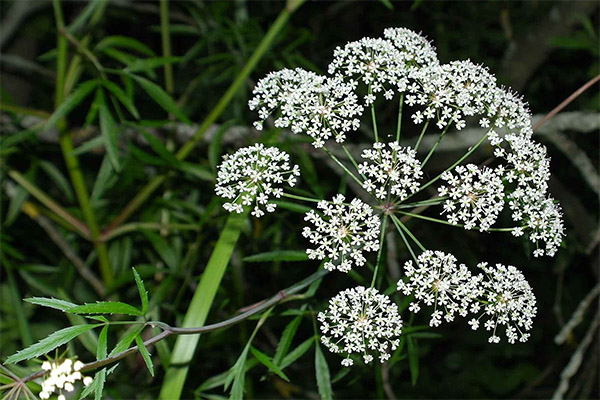
Preparations, decoctions and infusions based on it strengthen the immune system, have anticonvulsant, antiseptic, sedative effect. It is recommended as part of comprehensive therapy in the postoperative period to accelerate regeneration processes. Very valuable is the antitumor effect of the herb. Means on its basis can significantly slow the growth and spread of cancer cells in any part of the body.
In case of tuberculosis, positive dynamics is observed due to the antispasmodic action, relieving stressed cough and facilitating the discharge of sputum. During attacks of rheumatism and gout, the use of agents based on hemlock relieves inflammation and pain syndrome. Effective use of decoctions and alcoholic tinctures in patients with metabolic disorders, hemorrhoids, low blood pressure, thrombophlebitis, skin diseases, arthrosis, osteochondrosis.
For each disease there is a clear scheme of admission and a certain dosage. Violating the recommendations, you can easily turn the medicine into a poison. As a remedy, water and alcohol tinctures, oil, tea, decoction are used. In pharmacies, dried herb, ready-made tincture based on medical alcohol, oil are sold. Hemlock is part of a multi-component homeopathic drug Conium, prescribed for the treatment of enlarged lymph nodes, seizures, bronchial asthma. Dosages are microscopic, so the remedy is safe, but has a pronounced therapeutic effect.
Interesting: until the beginning of XX century, the plant was included in the official lists of pharmacopoeia, but then it was forbidden for use in official medicine because of high poisonousness.
Types of healing compositions
For a particular disease, the optimal dosage form is selected, so several variants are produced. Fresh leaves are used to relieve joint pain. They are crushed and applied to the problem area 3-4 times a day, soaking not more than 1 hour. In other cases, prior preparation of raw materials is required.
Infusion .
It is prepared very quickly. A teaspoon of fresh chopped leaves infused with a glass of boiling water in a thermos and infused for 6 hours. Shelf life when stored in the refrigerator is less than 5 days.
Tincture .
It is most often used for treatment, since it has a number of advantages:
- It stores for a long time;
- In the process of cooking, almost all of the complex of useful substances goes into the alcohol;
- it is conveniently dosed for use;
- has a long list of indications.
You can buy the tincture in a pharmacy or make it yourself. To do this, 30 g of dried herbs will need a little less than 0.5 liters of vodka. In a half-liter jar, the raw material is placed, which fills the container to 1/3. Then pour the liquid to the beginning of the neck. The jar is corked to prevent evaporation of alcohol vapor, and put away for 2 weeks in a dark cool place. Ready to remedy filtered, poured into a clean container and stored in the refrigerator.
Tincture Tishchenko
The recipe is very similar to the previous one, except for 2 points: only the inflorescences are taken for preparation and the jar is filled with raw materials almost to the top. Used to treat cancer of the esophagus, uterus, ovaries, breast, stomach. Used according to a scheme involving a gradual increase in the drug.
The dosage is given in drops, the intake is taken 1 hour before dinner. The course of treatment is very long, involves several approaches, which alternate with breaks.
The powder .
Obtained from thoroughly ground dry raw materials. Used externally to remove nasal polyps.
Tampons
The basis of fabric is impregnated with a therapeutic infusion. Its composition includes dried chamomile, sage, calendula in equal parts. They have anti-inflammatory, resolving, antibacterial action. To prepare a teaspoon of mixture pour a glass of boiling water and insist under a towel or terry cloth for 30 minutes. Then a tampon is dipped in the resulting liquid, and on top add 2-3 drops of water tincture of hemlock. Immediately inserted into the vagina at night. Used in combination therapy for endometriosis, uterine cancer and appendages, myoma, polyps.
Oil .
Dry leaves and inflorescences are stuffed tightly into a jar, filling it to 2/3. Pour the raw material in linseed oil or olive oil and put it in a dark place for 2 weeks. For use, it is filtered twice through several layers of gauze.
Oil-based ointment.
It is prepared in 2 steps. 10 g of dry crushed herbs insist in 100 ml of vegetable oil for 14 days. After it is ready, proceed to the second part. To do this, measure another 100 ml of olive oil and slowly heat until hot. While maintaining a constant temperature, the wax is added in small pieces, making sure that it dissolves completely. The criterion for the readiness of the mixture will be the change of its color to white. After this blank is removed from the fire and gradually cooled at room temperature to 45-48 degrees.
The final stage of preparation - combining with the herbal infusion and stirring to a homogeneous mass. The product is stored in the refrigerator. As necessary, the mass is formed into a small lozenge and applied to the sore spot. The remedy is effective in treating skin cancer, rust, tumors, hemorrhoids, cuts.
Hemlock enzyme
The remedy is prepared with the addition of whey. When interacting with the lactic acid medium, some of the toxins in the herb are neutralized, leaving a pain-relieving effect. For the preparation you will need:
- whey - 3 liters;
- dried leaves and inflorescences of wild parsley - 0,5 cup;
- sour cream - 1 tablespoon;
- sugar - 200 g.
All ingredients are mixed in a glass container and leave for fermentation for 14 days. Means taken during the day at 125 ml for 15 minutes before a meal.
The use of hemlock in traditional medicine
Despite the withdrawal of the plant from the official lists, it continues to be successfully used in single and multi-component gatherings. It has shown high efficacy in a number of serious diseases, including cancer. If you follow the frequency of intake, formulation and dosage, the benefits far outweigh the possible harms.
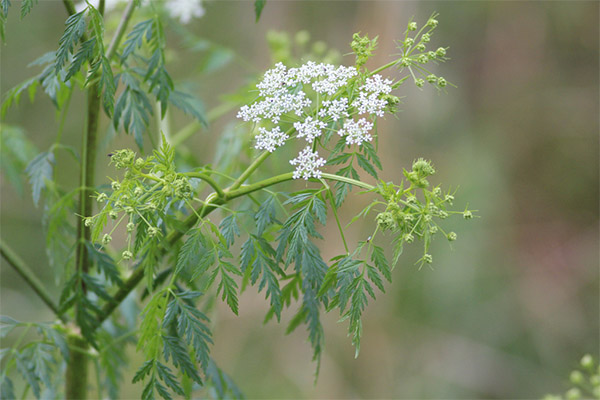
A distinction is made between cardinal and gentle ways of treatment. To the first refers intensive reception of a few drops of the remedy in equal stages during the day. Thus, a kind of shock therapy for the body is carried out, which awakens the deep reserves and directs them to fight the disease.
Warning: With this method of treatment, a close person must be near, who can give an antidote in the form of a glass of milk with the addition of manganese dioxide.
The second option is based on the principle of similarity and is used for long-term therapy in cancer patients. Treatment begins with 1-2 drops, the dosage gradually increases over several weeks. The body perceives alkaloids as a foreign element and begins to destroy together with cancer cells. There is no official confirmation of the method yet, but the effectiveness has been proven by decades of successful use of the method in folk medicine.
Tishchenko's method
Only the young shoots of hemlock are used for treatment, with no side effects in the form of irritation or suppression of emotional reactions. They have an analgesic effect, at the same time guaranteeing a shake to the weakened body, encouraging it to resist. An interval of 4 hours for taking the remedy is accurately observed.
There are several techniques that are designed for different degrees of resistance of the body. Very interesting and effective is the "Royal Method". The meaning is to gradually increase the dosage from 1 drop to 40 drops per day, and then gradually return to the original amount. This allows the body to adapt to the presence of the poison and suppress the development of the tumor with relative safety for other systems.
Hemlock in gynecology
The most effective methods of application are tampons and douches. Oil and alcoholic tincture are recommended for the procedures. They are not used in pure form, but must be diluted with oil or water, depending on the type of remedy.
Side effects
Before starting treatment, it is very important to be examined and record your state of health, because the main criterion for an overdose of the remedy is a change in well-being. Alarming symptoms are considered to be:
- change in the clarity of vision;
- burning of the tongue and throat;
- uncontrolled salivation;
- attacks of choking;
- dizziness, increasing pain in the temples and the back of the head;
- nausea and vomiting;
- loss of strength, onset of apathy.
The simultaneous occurrence of 3 or more signs signals the maximum dosage of hemlock and the onset of poisoning. Tishchenko, who created the cyclo methodology, believes that the limiting dose is 40 drops of tincture per day. But individual characteristics of the body and the reaction to alkaloids are different for everyone, which makes certain adjustments to the treatment regimen. For some people even 25 drops becomes an overwhelming burden, after which they will have to take an antidote and stop the course for a while, resuming it a few days later with a much smaller number of tincture drops.
At a sharp deterioration of the condition to delay calling an ambulance is dangerous to the life of the patient. The main signs are numbness rising from the legs upward, depressed breathing, pale skin, changes in the size of the pupil. It is necessary to specify the reason for the call, as poisoning quickly affects the respiratory system, may need forced ventilation of the lungs and the introduction of a specific antidote.
Contraindications
A complete ban on treatment with hemlock is imposed in pregnancy, breastfeeding, individual intolerance. Caution is exercised when taking any remedy on the basis of angelica dogwood with renal failure, epilepsy, exhaustion, liver disease. Children's age and surgery are also considered contraindications.
With exact observance of the recipe and dosage, careful observation of well-being and control of the blood condition, severe consequences can be avoided, receiving from the treatment only benefits. Means on the basis of hemlock often cope in those cases where official medicine sadly shrugs its hands, relegating patients to the category of chronic or incurable.
Interesting facts

- The spotted plant was named for the spots on the stem that appear on the adult specimen in the second year of life.
- The peak of the toxicity of the sap of angelica dogwood comes before flowering, and from the moment the seeds are formed, the main mass of alkaloids moves into them.
- Young plants are more gentle on the body, less likely to cause poisoning.
- Hemlock is so undemanding that it grows even near railroad tracks and landfills without much discomfort.
- In ancient times hemlock was used for public executions.
- The antidote to the alkaloid conium, which paralyzes the muscles of the respiratory system, is milk with the addition of manganese.
- Treatment with an alcohol tincture slows the growth of cancer cells and has an analgesic effect.
- Wild parsley growing on the territory of Scotland has almost lost its poisonous properties, in the Armenian national cuisine it is used for preparation of some dishes.
- Any part of the plant gives off an unpleasant smell reminiscent of mouse.
- Outwardly, the young shoots of hemlock resemble the leaves of parsley.
If safety precautions are observed, hemlock becomes an amazingly effective medicine.
«Important: All information on this site is provided for informational purposes only. for informational purposes only. Please consult with your health care professional before using any of the recommendations. specialist before using any of the recommendations. Neither the editors nor the authors shall be liable for any possible harm caused by materials."

